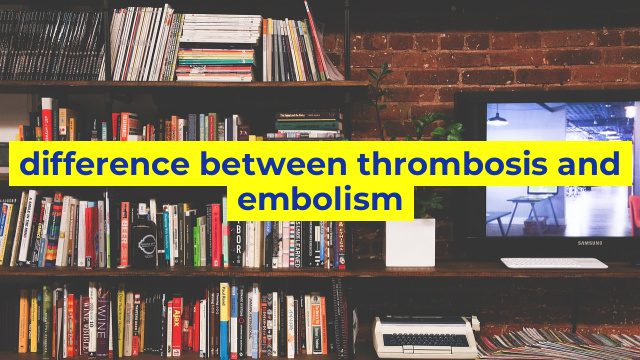The Difference Between Thrombosis and Embolism
Thrombosis and embolism are two medical conditions that are often confused with each other. Although both conditions are related to blood clots, they have distinct characteristics and treatments. In this article, we will discuss the difference between thrombosis and embolism.
What is Thrombosis?
Thrombosis is the formation of blood clots inside a blood vessel, which can obstruct blood flow to vital organs. It is a common condition that can occur in any part of the body, including the veins, arteries, and heart. There are several factors that can increase the risk of thrombosis, including obesity, smoking, pregnancy, and a sedentary lifestyle.
Thrombosis can cause different symptoms depending on where it occurs in the body. For example, deep vein thrombosis (DVT) can cause leg pain, swelling, and redness, while pulmonary embolism (PE) can cause shortness of breath or chest pain. Treatments for thrombosis may include blood thinning medications, compression stockings, or surgery.
What is Embolism?
Embolism is a condition where a blood clot or foreign object, such as a piece of plaque, travels through the bloodstream and lodges in a blood vessel, obstructing blood flow to vital organs. The most common type of embolism is a pulmonary embolism, which occurs when a blood clot in the leg or pelvic vein travels to the lung.
Embolism can cause sudden and severe symptoms, such as chest pain, shortness of breath, and coughing up blood. It can be life-threatening if not treated immediately. Treatments for embolism may include blood thinning medications, thrombolytic therapy, or surgical removal of the clot.
The Difference between Thrombosis and Embolism
The main difference between thrombosis and embolism is the location of the blood clot. Thrombosis occurs when a blood clot forms inside a blood vessel, while embolism occurs when a blood clot or foreign object travels through the bloodstream and obstructs a blood vessel somewhere else in the body.
Thrombosis can occur due to a variety of factors, including poor circulation, injury, or medical conditions such as cancer or heart disease. Embolism, on the other hand, is often caused by a blood clot that forms in a deep vein, which can break off and travel to the lungs, heart, or brain.
In conclusion, thrombosis and embolism are two medical conditions that are related to blood clots. While they share some similarities, they have distinct characteristics and treatments. It is important to understand the difference between the two conditions and seek medical attention if you experience any symptoms.
Table difference between thrombosis and embolism
| Thrombosis | Embolism |
|---|---|
| Formation of a blood clot inside a blood vessel | Blockage of a blood vessel by a traveling blood clot or foreign material |
| Occurs at the site where the clot forms | Occurs at a location distant from where the clot forms |
| Can occur due to a variety of reasons including poor blood flow, injury to the lining of a blood vessel or blood disorders | Often occurs due to traveling blood clots or foreign material dislodged from another part of the body |
| May lead to damage to the affected blood vessel, restricted blood flow and tissue damage | Can result in a sudden and severe restriction of blood flow to an organ or tissue, leading to tissue death if left untreated |
| Treatment may involve medications to dissolve or prevent the formation of blood clots and surgery in severe cases | Treatment may involve medications to dissolve or prevent the formation of blood clots and surgical removal of the clot or foreign material causing the blockage |
